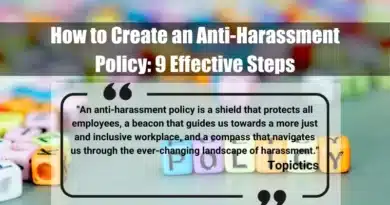Empowering Clear Communication Skills Against Harassment
Takeaways
| Key Points |
|---|
| Clear communication is a vital tool for addressing harassment and fostering a respectful environment in any context. |
| It begins with self-awareness, understanding your communication strengths and weaknesses, and recognizing unconscious biases that might impact your interactions. |
| Establishing and articulating boundaries, using “I” statements, and enforcing consequences assertively yet calmly are essential to prevent and address inappropriate behavior. |
| Active listening, empathy, and adapting your communication style to different scenarios, whether in the workplace, online, or personal relationships, allow you to handle harassment effectively while maintaining your composure. |
| Ultimately, building a culture of respect, cultivating a supportive network, and challenging harmful behaviors collectively empower individuals and communities to eliminate harassment and create spaces that thrive on mutual understanding and dignity. |
Introduction
Imagine you’re at work, minding your own business, when a colleague makes an unwelcome comment. It could be a joke that crosses the line or a backhanded compliment that feels invasive. You know something’s wrong, but the words get caught in your throat. Maybe you fear confrontation or worry about appearing “sensitive.” This is where the power of clear communication comes in.
Harassment, in its various forms, thrives in the shadows of unclear expression and unspoken boundaries. It can be verbal, physical, or even online, creating a hostile environment that impacts mental and emotional well-being.
Addressing it effectively requires speaking up, which demands clear communication skills.
Building a Foundation for Clear Communication

A. Know Yourself, Master, Your Voice
Think of your communication style as your unique superpower. Knowing your strengths and weaknesses is crucial for using it effectively.
1. Discovering Your Communication Strengths
Are you a wordsmith who crafts eloquent sentences? Or a direct speaker who gets straight to the point? You may excel at reading body language and picking up on subtle cues. Recognizing your strengths helps you leverage them in challenging situations.
2. Facing Your Communication Weaknesses
Everyone has areas for improvement. You may shy away from conflict, struggle to express emotions clearly or have difficulty setting boundaries. Identifying these weaknesses empowers you to work on them, building a well-rounded communication repertoire.
3. Recognizing Biases and Blind Spots
We all have unconscious biases that can impact how we communicate. Are you more assertive with certain people? Do you unintentionally interrupt others? Examining these biases helps you communicate more fairly and effectively.
Remember, self-awareness is a journey, not a destination. Be patient with yourself, and don’t hesitate to seek feedback from trusted friends or mentors to gain different perspectives.
B. Boundaries: Your Communication Castle Walls
Clear boundaries are essential for preventing and addressing harassment. They define what you find acceptable and unacceptable behavior.
1. Defining Your Boundaries
Boundaries vary by situation and relationship. Consider your comfort level with physical contact, humor, and personal questions. Define clear boundaries for yourself and be prepared to articulate them to others.
2. Communicating Expectations with Respect
Setting boundaries doesn’t have to be confrontational. Use “I” statements like “I feel uncomfortable when…” or “I appreciate it when…” to communicate your expectations respectfully and clearly.
3. Enforcing Boundaries Assertively, Not Aggressively
Assertiveness is key. Stand firm and clear about your boundaries without resorting to aggression or personal attacks. Remember, enforcing boundaries is about protecting yourself, not controlling others.
C. Active Listening: Putting Yourself in Their Shoes (Without Wearing Them)
Active listening is more than just hearing words. It’s about truly understanding the other person’s perspective, even if you disagree.
1. Beyond Nodding and Smiling: Active Listening Techniques
- Pay attention: Give the speaker your full attention verbally and nonverbally.
- Ask clarifying questions: Do not assume you understand everything. Seek clarification to ensure you’re on the same page.
- Summarize key points: Show your engagement by summarizing what you’ve heard to confirm your understanding.
2. Empathy: Feeling Their Feels Without Losing Your Ground
Empathy doesn’t mean condoning behavior. It means acknowledging the other person’s emotions without agreeing with their actions. This can help de-escalate situations and create opportunities for constructive dialogue.
By building this foundation of self-awareness, clear boundaries, and active listening, you’re preparing yourself to communicate effectively against harassment.
Communicating Directly and Assertively: Unsheathing Your Verbal Sword

A. Addressing Unwanted Behavior like a Boss (Without Being One)
Facing harassment takes courage, but you don’t have to go Rambo. Direct and assertive communication helps you express your concerns effectively, setting the tone for a respectful resolution.
1. The “I” Statement: Your Communication Superpower
“I” statements focus on your feelings and experiences and avoid accusations and blame. Instead of saying, “You’re being so offensive,” try, “I feel uncomfortable when you comment about my appearance.”
2. Assertive Communication: No More Doormats Allowed
Being assertive doesn’t mean yelling or being aggressive. It means expressing your needs and concerns confidently and clearly while respecting the other person’s right to their own opinion.
3. De-escalation Techniques: When Things Get Heated
Sometimes, situations can get tense. Here are some de-escalation tips:
- Stay calm and collected: Breathe deeply and maintain a calm demeanor to avoid fueling the fire.
- Use “I” statements and open-ended questions: Redirect the conversation towards understanding their perspective.
- Set boundaries and consequences: Clearly state what behavior is unacceptable and what the consequences will be if it continues.
- Know your limits: If things escalate beyond your comfort zone, excuse yourself and seek help from a trusted adult or authority figure.
B. Setting Consequences and Saying “Nope”: The Art of Following Through
Setting consequences lets the other person know you won’t tolerate unacceptable behavior. But without follow-through, they’re just empty threats.
1. Defining Clear and Proportional Consequences
Consequences should be clear, specific, and relevant to the situation. For example, if someone makes inappropriate jokes, a consequence could be limiting interactions with them.
2. Communicating Consequences Calmly and Firmly
Deliver consequences calmly and firmly, explaining why the behavior is unacceptable and the repercussions if it continues. Avoid anger or aggression, as it can undermine your message.
3. Following Through is Key: Consistency is King (or Queen)
The real test comes with follow-through. If you set a consequence, stick to it! Consistency shows you mean business and prevents mixed messages. Remember, setting and enforcing boundaries is about self-respect, not punishment.
C. Saying No and Setting Limits: It’s Okay to Be Picky
Learning to say “no” and set limits empowers you to control your interactions and prevent unwanted behavior.
1. The Power of “No”: Saying It Loud and Proud
Saying “no” doesn’t have to be complicated. A simple “No, thank you” or “I’m not comfortable with that” is enough. Don’t feel obligated to apologize or explain yourself excessively.
2. Setting Limits Like a Pro: Different Situations, Different Rules
Limits vary depending on the situation and relationship. You might set more boundaries with colleagues than close friends. Know your comfort level and communicate it clearly.
3. Dealing with Pressure and Manipulation: Don’t Fall for the Tricks
People sometimes try to pressure or manipulate you into accepting unwanted behavior. Recognize these tactics and stay firm in your boundaries. You can say things like, “I appreciate your offer, but I’m not interested,” or “I understand you might not agree, but my decision is final.”
By mastering direct and assertive communication, you become empowered to address harassment confidently and effectively. Remember, your voice matters, and speaking up can create positive change.
Communicating in Different Contexts: Adapting Your Voice to Every Stage

A. Navigating Difficult Conversations: From Work Woes to Cyber Bullies
Harassment doesn’t discriminate based on location. Let’s explore tackling it in different settings:
1. The Workplace Battlefield: Standing Up for Yourself at Work
Workplace harassment can be tricky, but remember, you have rights. Here’s how to navigate:
- Directly address the behavior with the person if comfortable. Use “I” statements and set boundaries firmly.
- Report the incident to HR or a supervisor. Document everything, including the incident’s date, time, and details.
- Seek support from trusted colleagues or employee assistance programs.
2. Online Onslaught: Taming the Digital Dragons
Cyberbullying can sting. Here’s your digital shield:
- Don’t engage with the bully. Responding can fuel the fire. Block them and report the abuse to the platform.
- Collect evidence, like screenshots or messages. This can be useful if you need to report the incident to authorities.
- Talk to someone you trust, like a friend or family member.
3. Personal Relationships: Setting Boundaries with Loved Ones
Even loved ones can cross lines. Here’s how to address it:
- Have an open and honest conversation when things are calm. Use “I” statements and explain how their behavior affects you.
- Seek professional help or mediation if needed. External guidance can facilitate understanding and resolution.
Remember, it’s okay to distance yourself from harmful relationships. Prioritize your well-being.
4. Bystander Intervention: Being a Hero Without a Cape
Witnessing harassment? Here’s how to become an impactful bystander:
- Express concern for the target and offer support. Ask them if they’re okay and if they need help.
- If it is safe, directly challenge the behavior. Speak up against what’s happening, using clear and assertive language.
- Report the incident to a trusted adult or authority figure. Don’t let the behavior go unchecked.
Remember, the key is to adapt your communication style to different contexts. Be mindful of your audience, choose appropriate methods, and always prioritize your safety and well-being.
B. Communicating with Authority Figures: Seeking Help and Advocating for Yourself
Sometimes, you need to involve others in addressing harassment. Here’s how to communicate effectively with authority figures:
1. Reporting Harassment: Clarity and Confidence are Your Allies
Be clear, concise, and factual when reporting harassment. Provide specific details, dates, and names if possible. Remain calm and confident, even if the other person tries to minimize your experience.
2. Advocating for Yourself: Persistence is Your Power
Be bold and follow up on your report, asking for updates. If you’re unsatisfied with the response, seek help from legal professionals or advocacy groups. Remember, you have the right to be heard and protected.
Effective communication with authority figures can provide access to support, resources, and justice. Don’t hesitate to speak up and advocate for yourself – your voice matters!
Fostering a Culture of Clear Communication

Harassment thrives in silence. But by fostering a culture of clear communication, we can create a world where it has no room to grow. Think of it as building a fortress of respect, brick by supportive brick.
A. Building Your Support Network: Your Communication Squad
We all need allies in the fight against harassment. Let’s build a strong support network:
1. Identifying Trusted Allies: Look for the Communication Champions
Surround yourself with people who listen actively, respect your boundaries, and support your well-being. Seek mentors, friends, family members, or colleagues who share your values.
2. Communicating Openly and Honestly: Transparency is Key
Share your experiences with trusted allies. Open communication fosters understanding and allows them to offer support and advice. Remember, you don’t have to go through this alone.
3. Utilizing Collective Voice and Advocacy: Strength in Numbers
Team up with your support network to advocate for change. Speak up together, raise awareness, and challenge harmful behavior as a united front. Remember, collective action can have a powerful impact.
B. Promoting Respectful Communication Practices: Paving the Way for a Better World
Let’s make clear and respectful communication the norm:
1. Cultivating a Culture of Mutual Respect: Start with Yourself
Treat everyone with dignity and respect, regardless of their differences. Lead by example and encourage others to do the same.
2. Choosing Your Words Wisely: Words Have Power
Be mindful of the language you use. Avoid discriminatory jokes, harmful stereotypes, and insensitive comments. Choose words that build up, not tear down.
3. Challenging Harmful Language and Behavior: Don’t Be a Silent Bystander
When you witness disrespectful or harassing behavior, speak up safely and appropriately. Challenge it politely but firmly, and encourage others to do the same. Remember, silence can be interpreted as consent.
By building a clear and respectful communication culture, we can create a world where harassment feels out of place; its voice drowned out by the chorus of understanding and support. Remember, change starts with each of us. So, let’s keep the conversation going, one empowered voice at a time!
Conclusion: Your Voice, Your Power
The fight against harassment requires ongoing commitment. Utilize the resources listed below to continue learning, advocating, and empowering yourself and others. Remember, you are not alone. Through clear communication and collective action, we can build a world where harassment loses its voice and respect resonates loud and clear.
FAQ
What is ‘assertive communication’ in the context of preventing harassment?
Assertive communication involves expressing one’s thoughts, feelings and needs openly and honestly while respecting others. Preventing harassment empowers individuals to set clear boundaries and address inappropriate behavior directly, reducing the likelihood of escalation.
How does ‘active listening’ contribute to addressing harassment issues?
Active listening entails fully concentrating, understanding, and responding thoughtfully to what others say. In harassment situations, it ensures that victims feel heard and supported, fostering a culture where concerns are taken seriously and addressed promptly.
What role does ‘non-verbal communication’ play in harassment prevention?
Non-verbal communication includes body language, facial expressions, and gestures. Awareness of non-verbal cues helps individuals recognize discomfort or distress in others, allowing for timely intervention and support in potential harassment scenarios.
Can you explain ‘bystander intervention’ in preventing harassment?
Bystander intervention refers to the actions taken by witnesses to prevent or stop inappropriate behavior. Training employees to recognize and intervene safely in harassment situations promotes a proactive approach to maintaining a respectful workplace.
What is the significance of ‘clear boundary setting’ in communication?
Clear boundary setting involves explicitly stating acceptable and unacceptable behaviors. This clarity helps prevent misunderstandings and ensures that all parties are aware of the limits, reducing the chances of harassment.
How does ‘feedback delivery’ relate to preventing harassment?
Effective feedback delivery involves providing constructive criticism or praise in a manner that promotes positive change. In the context of harassment, promptly and respectfully delivering feedback about inappropriate behavior can deter future incidents.
What does ‘conflict resolution’ entail concerning harassment?
Conflict resolution involves addressing and resolving disputes constructively. Implementing conflict resolution strategies in the workplace can address underlying issues that may lead to harassment, fostering a healthier environment.
How is ’empathy’ crucial in communication to prevent harassment?
Empathy is the ability to understand and share the feelings of others. Demonstrating empathy in workplace interactions fosters a supportive atmosphere, making individuals less likely to engage in or tolerate harassment.
Can you define ‘high-context communication’ and its relevance to harassment?
High-context communication relies on implicit messages and non-verbal cues. Understanding this style is essential in diverse workplaces to ensure indirect or culturally specific communication does not lead to misunderstandings or perceived harassment.
What is ‘low-context communication,’ and how does it impact harassment prevention?
Low-context communication is direct and explicit, with most information conveyed through words. Encouraging clear and straightforward communication can minimize ambiguities that might otherwise lead to harassment or unintentional offenses.
How does ‘transparent communication’ help in addressing harassment?
Transparent communication involves openness and honesty when sharing information. In the context of harassment, it ensures that policies, procedures, and expectations are clear and that any incidents are addressed openly, fostering trust within the organization.
What is ‘power dynamics awareness’ in workplace communication?
Power dynamics awareness involves recognizing the influence of hierarchical relationships on interactions. Understanding these dynamics is crucial in preventing harassment, as power imbalances can often lead to or exacerbate inappropriate behavior.
Can you explain ‘cultural competence’ and its role in preventing harassment?
Cultural competence is the ability to interact effectively with people from diverse backgrounds. Harassment prevention ensures that communication respects cultural differences, reducing the risk of misunderstandings or culturally insensitive behaviors.
How does ’emotional intelligence’ factor into harassment prevention?
Emotional intelligence is the ability to recognize and manage one’s own emotions and those of others. High emotional intelligence in the workplace promotes better understanding and management of interpersonal relationships, thereby reducing the likelihood of harassment.
What is the importance of ‘confidentiality protocols’ in handling harassment complaints?
Confidentiality protocols are guidelines to protect the privacy of individuals involved in harassment complaints. Maintaining confidentiality encourages victims to come forward without fear of retaliation, ensuring that issues are addressed appropriately and sensitively.









